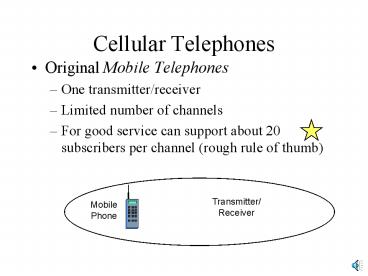Cellular Telephones - PowerPoint PPT Presentation
1 / 23
Title:
Cellular Telephones
Description:
... Telephones. Divide Region into Cells. One cellsite (transmitter/receiver) per cell ... message to cellphone via that cellsite, telling the phone what incoming, ... – PowerPoint PPT presentation
Number of Views:80
Avg rating:3.0/5.0
Title: Cellular Telephones
1
Cellular Telephones
- Original Mobile Telephones
- One transmitter/receiver
- Limited number of channels
- For good service can support about 20 subscribers
per channel (rough rule of thumb)
Transmitter/ Receiver
Mobile Phone
2
Cellular Telephones
- Divide Region into Cells
- One cellsite (transmitter/receiver) per cell
- Channels can be reused in non-adjacent cells
Yes
No
Can Reuse Ch. 232?
Uses Channel 232
No
No
Yes
Yes
No
No
Channel 232 Used in 4 cells
No
3
Cellular Telephones
- Channel Reuse
- Without channel reuse, you can serve only about
20 subscribers per channel for good service - Rough rule of thumb
- Otherwise, the system will not be available too
often when people want to call or receive calls
4
Cellular Telephones
- Channel Reuse Rule
- How many times can we reuse each channel in an
area? - Channel reuse factor Number of cells / 7
- If 20 cells, reuse factor is about 3 (round off)
- Can reuse each channel about 3 times
- Rough rule of thumb
5
Cellular Telephones
- Capacity Calculation
- If 100 channels and 15 cells
- 100 channels
- x 20 subscribers per channel
- x 15/7 channel reuse factor
- about 4,000 subscribers (100 x 20 x 2)
6
Handoffs
- When you move to another cell within the same
system, you get a handoff - You are transferred automatically to that cells
cellsite
7
Roaming
- Roaming is when you take your cellphone to
another city - Use it there to send and receive
- Not always possible technically because of
incompatible cellular technology - May be limited procedurally because of high rates
of cellular fraud in some areas - Dont confuse this with handoff, which takes
place within a cellular system between cells
8
Control
- Mobile Telephone Switching Office
- Controls cellsites, handoffs, etc.
- Calls go to/from MTSO
- Connects to POP to link to traditional telephone
(wireline) carriers
POP
MTSO
ILEC, ICX, etc.
9
Placing a Call
New
- Enter number, hit send
- Cellphone broadcasts request
- Several cellsites receive, send to MTSO
- MTSO assigns cellphone to cellsite where signal
is loudest - MTSO sends message to cellphone via that
cellsite, telling the phone what incoming,
outgoing channels to use
10
Receiving a Call
New
- MTSO has each cellsite broadcast cellphones ID
number - Cellphone transmits a response
- Responses from cellsites go to MTSO
- MTSO selects cellsite where signal is loudest
- MTSO sends message via the cellsite to cellphone,
giving channels and telling the cellphone to ring
11
First Generation Cellular
- Analog or Digital Operation
- Initially analog U.S. States initially was
analog using the AMPS standard - Limited use of digital Cellular Digital Packet
Data (CDPD) standard - Europe and the rest of the world started with a
large number of incompatible analog systems but
settled on the digital GSM standard
12
First-Generation Cellular
- Large Cells
- Usually only 20-40 per city
- Limits channel reuse
- Limited Number of Channels
- In U.S., 832 two-way channels
- No Compression
- Each voice signal required a full two-way channel
13
First-Generation Cellular
- How Many Subscribers Can You Support?
- 20 cells
- Channel reuse is about 3 (20/7)
- 832 channels
- With channel reuse, 2,496 effective channels
- 20 users per available channel
- So only about 50,000 subscribers per city
- Engineering tricks can extend, but only somewhat
14
Second-Generation Cellular
- Personal Communication Service (PCS)
- Or Personal Communication Network (PCN)
- More channels
- About 2,500
- Smaller cells permit more channel reuse
- Dont just say smaller cells be explicit about
channel reuse - Compression of around 31
- Supports more subscribers per channel
15
Second-Generation Cellular
- Digital
- Cleaner signal
- Paging and other digital services
- Internet access
16
Potential System Capacity (Roughly)
- Category 1st Gen 2nd Gen
- Cells/City 30 100
- Channel reuse (cells/7) 4 14
- Channels 800 2,500
- Effective channels 3,200 35,000
- With compression 3,200 105,000
- Subscribers (x20/channel) 64,000 2,000,000
- No compression in 1st generation
17
Second-Generation Cellular
- PCS Cellphones
- Do not have to transmit as far because cells are
smaller - Inverse cube law--if triple distance, 33 or 27
times the power required - Cellphones can be less expensive because use less
power
18
Second-Generation Cellular
- PCS Cellphones
- Large number of possible subscribers removes
scarcity cost penalties - But vendors try to avoid simple price competition
by offering more services made possible by
digital technology
19
Second-Generation Cellular
- Most of World
- Standardizing on DCS Technology
- Based on GSM and usually called GSM
- U.S.
- FCC did not specify a standard!
- Different carriers use different technologies
- Some have standardized on GSM
- Your cellphone may not work with another carrier
- Limits roaming
20
Generations Recap
1st
2nd
Analog/Digital
Both AD
Digital
Cells
Large
Small
Channels (Approx.)
800
2500
Compression
No
Yes
U.S. Standardization
AMPS
Poor
International Standards
GSM
DCS
21
Second-Generation Cellular
New
- Data
- Initially limited to about 10 kbps
- 100 kbps coming over second-generation systems in
some countries
22
Third-Generation (3G)
- Smarter Devices
- Devices will have the power of a small PC
- Greater Number of Uses
- Data, including internet access
- Graphics and even video
- International Mobile Telecommunications (IMT)
- European-led standard for 3G generation cellular
23
Third-Generation (3G) Cellular
New
- Data
- Up to 3 Gbps































